Electric fields
We've been building up to this picture of how electric forces work:
- A charge gives rise to an electric field
- If there's a second charge around, it feels a force.
- The direction of the force can be calculated from the direction of the electric field.
CC13 - Chapter 9
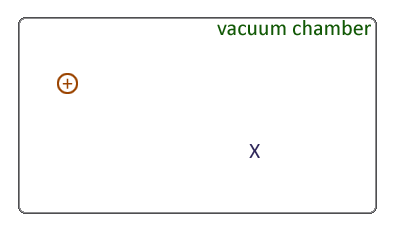 A proton is placed at rest in the middle of a vacuum chamber. Neglecting
everything but the proton, at another point X in the chamber there is...
A proton is placed at rest in the middle of a vacuum chamber. Neglecting
everything but the proton, at another point X in the chamber there is...
- an electric field,
- an electric force,
- none of the above, since after all, there is nothing at X.
- a magnetic field, No--only if the electric charges are moving.
A proton *does* have a charge. It is positively charged.
"We think there are fields there because it holds the possibilities. There just aren't any forces."
The electric field points in the direction of the force that a positive charge *would feel* if it were located there.
But a negative charge would feel a force in the opposite direction. Draw the field of the proton at locaton X.
Fields and forces
The electric field is not a force.
But the electric field points in the direction of the force that a positive charge would feel at that position...
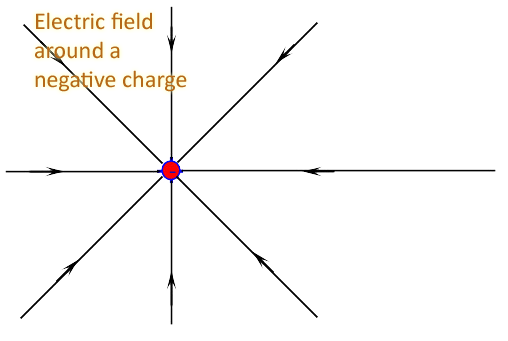
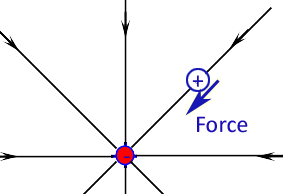 The electric
field points in the direction of the force that a positive charge
would feel at that position.
The electric
field points in the direction of the force that a positive charge
would feel at that position.
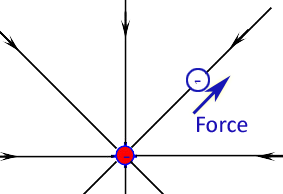 A
negative charge would feel a force in exactly the opposite direction from
the force on a positive charge.
A
negative charge would feel a force in exactly the opposite direction from
the force on a positive charge.
What if....?
- You had a "stick" with some electrons that are free to move in it [aka "a wire"],
- A device that let you create an electric field that points first left,
then right, left, right, left.....
- what if those electrons "rubbed" up against atoms in the wire as they moved back and forth?
Lightning
Thunderclouds acquire a charge (more about that below) opposite from the earth. Imagine that there are many negative charges along the bottom of a thundercloud, and many positive charges distributed over Earth's surface. What does the field look like in the region between cloud and Earth?

A typical molecule of air (say $N_2$) is neutral. What's the direction of the force due to the electric field on such a molecule?
But the "pieces" of a Nitrogen molecule are charged. It is only neutral because it has the same number of protons (in the nuclei) and electrons.
- In what direction are the electrons pulled by the electric field?
- In what direction are the nuclei pulled?
Now, crank up the electric field... What might happen if you pull hard *enough* on the electrons and protons?
Particles that are not neutral are called ions. In what direction would they move?
Moving ions can de-stabilize other molecules in their path which are stretched "almost to the breaking point".

$\Rightarrow$ Lightning happens...1) more or less along the direction of the field, 2) Happens along a few "lines" (lightning bolts) rather than all throughout the region of intense electric field.
Where does the charge in the clouds come from?
It is not completely clear, but it appears to be a sort of "triboelectric effect" as rising water molecules (water vapor) rub against other molecules.
This rubbing effect leading to static electric charges is seen even more dramatically in the clouds of ash swirling out of volcanoes.
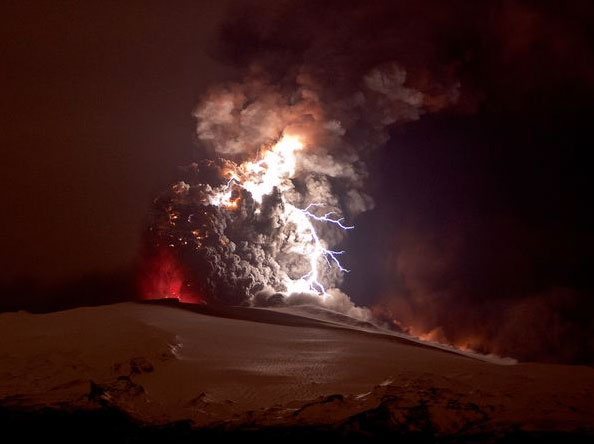
Dipole [in-class writing]
A "dipole" is two opposite charges that are somehow rigidly connected (by a "stick") like a sort of dumbell. Now imagine that such a dipole is placed in a region where the electric field is pointing to the right. What are the forces that arise because of the field?
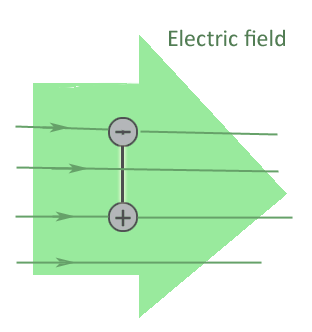 1. Sketch the dipole as shown. Now draw an arrow pointing
in the direction of the force that the + charge feels because of the electric
field pointing to the right.
1. Sketch the dipole as shown. Now draw an arrow pointing
in the direction of the force that the + charge feels because of the electric
field pointing to the right.
2. Draw an arrow pointing in the direction of the force that the - charge feels because of the electric field pointing to the right.
3. Would the net effect of both of these forces be to pull the dumbell to the right? to the left? or neither?
4. Well, how would *you* describe that motion that will result from these forces?
The idea of a dipole is useful as a kind of cartoon view of a water molecule (or other "polar molecules"), because these have more negative charge on one side, and more positive charge on the other.
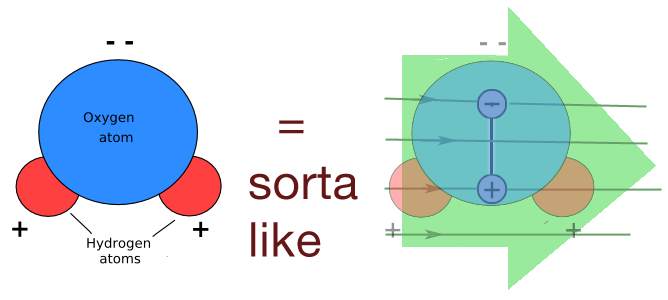
Microwave oven
In a microwave oven, the field is rapidly switched back and forth. Now left, now right, now left....
What happens when you put your water molecule dipole in such an electric field that's sloshing right and left?
Why don't microwaves heat things like plates / cups?
The material in plastics / ceramics...
- Is not polar (well, not very).
- is "insulating". That is, the electrons are very tightly bound to the nuclei, and they are not free to move.
Death rays?!
Humans are, to a large extent water.
Could you shoot a "death ray" or "heat ray" at someone? Maybe a concentrated microwave to heat somebody up remotely?
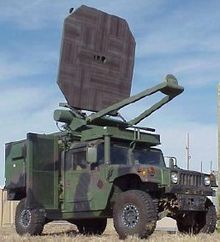 Actually,
the U.S. military is developing so-called "Active
Denial Systems"
that do just that. These could be used for crowd control.
Actually,
the U.S. military is developing so-called "Active
Denial Systems"
that do just that. These could be used for crowd control.
Apart from the politics(!) critics say that water cannons already work well.
It might be simple to protect yourself from this... Make a shield of aluminum foil.